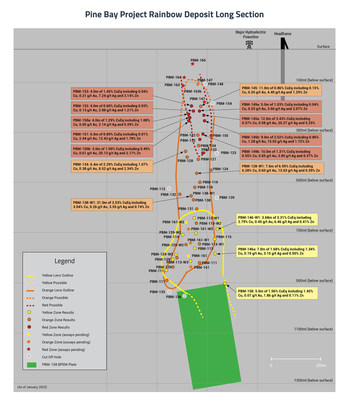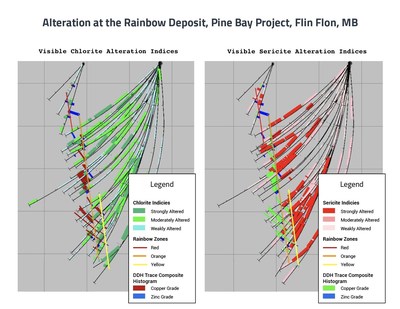Callinex Announces Expansion of Rainbow Deposit to Surface and at Depth with Multiple Copper-Gold-Zinc Assays
Callinex Mines Inc. (OTCQX: CLLXF) announced positive drilling results from its Rainbow Deposit, located at the Pine Bay Project in Manitoba. Notable highlights include drill hole PBM-158, which intersected 5.0m of 1.56% copper equivalent at a depth of 928m, marking the deepest hole to date. The borehole electromagnetic survey suggests potential for further extensions at depth. Additionally, a newly discovered Red Zone exhibited high-grade copper-gold-zinc assays, with PBM-145 returning 12.0m of 3.43% copper equivalent. The company plans further exploration targeting known deposits and expanding upon previous findings.
- Drill hole PBM-158 intersected 5.0m of 1.56% copper equivalent at 928m depth, indicating significant mineralization.
- Successful borehole electromagnetic survey suggests further potential for the Rainbow Deposit at depth.
- Discovery of the Red Zone with assays like PBM-145 returning 12.0m of 3.43% copper equivalent, enhancing resource estimates.
- Overall drilling results from 71 holes totaling 39,950m show continuous high-grade copper presence.
- Assay results from 7,540m of drilling from 17 holes completed in Q4 2021 are still pending, causing uncertainties.
- Limited drilling at the Nash Creek Project revealed no appreciable amounts of silver, diverging from campaign goals.
Insights
Analyzing...
Highlights:
- Rainbow open at depth with deepest intercept at Rainbow to date, a 225m step-out from previous deepest hole (PBM-111);
- Subsequent borehole EM survey supports the extension of Rainbow at depth; and
- Multiple near surface copper-gold-zinc assays at the newly discovered Red Zone.
VANCOUVER, BC, Jan. 31, 2022 /PRNewswire/ - Callinex Mines Inc. (the "Company" or "Callinex") (TSXV: CNX) (OTCQX: CLLXF) is pleased to announce results from an additional 13 drill holes encompassing 5,490m of drilling from the 2021 exploration campaign to expand the high-grade copper, gold, silver and zinc Rainbow Deposit (the "Rainbow"). Assay results from 7,540m of drilling from 17 drill holes completed in Q4 2021 are still pending. The Rainbow is located at the
The interpreted strike and plunging direction has been widened and opened up significantly at depth with the intersections of the Yellow Zone in drill holes PBM-146a, PBM-146-W and PBM-158. Drill hole PBM-158, the deepest and most northern hole intersected to date at Rainbow, returned 5.0m of
Jim Pickell, member of Callinex's technical team, stated, "Given the intense geochemical alteration patterns and favourable geology at the deepest explored levels of the Rainbow VMS deposit, it is exciting that a newly defined strong borehole (PBM-158) geophysical anomaly is located immediately below those high-grade massive sulphides."
A subsequent borehole electromagnetic ("BPEM") survey completed and modeled from PBM-158 indicates significant potential for Rainbow to continue at depth. This is also supported by intense sericite and chlorite alteration that is strongest in the deepest holes drilled into the deposit (Rainbow Alteration Cross Section). The Yellow Zone starts up at 600m below surface and has a strike of 225m based on this most recent intersection. Typically Volcanogenic Massive Sulphide ("VMS") lenses discovered in the Flin Flon Greenstone belt have a depth extent that's 5-8 times the strike.
Alan Vowles, member of Callinex's technical team, added, "I am quite encouraged by the off-hole anomaly in PBM-158 because the Tau indicates it is even a little more conductive than the original off-hole target in PBM-033 that we drilled and discovered the Rainbow. Additionally, because the off-hole target in PBM-158 is below the hole it indicates strong potential that Rainbow continues at depth".
The BPEM anomaly modeled from PBM-158 measures 190m by 400m. The Time Constant or Tau, a measure of conductance, of the off-hole anomaly in PBM-158 is 27.07 milliseconds (ms). By comparison, the Tau of the anomaly in PBM-033, which vectored to the discovery of Rainbow, was 22.87 ms.
Six drill holes announced have intersected a newly discovered copper-gold-zinc rich Red Zone that remains open towards surface and has been intersected to a depth of 375m below surface. The Red Zone is highlighted by drill hole PBM-145 which returned 12.0m of
JJ O'Donnell, Callinex Exploration Manager, stated, "We are pleased to have delineated a new zone as we continue to test the Rainbow horizon to surface. The recent drilling in the Red Zone has produced the highest returned assays for gold and zinc (PBM-145 266m-267m @ 4.29 g/t Au, PBM-145 235m-236m @
Delineation drilling of Rainbow continues to return high-grade copper. PBM-138-W1 intersected the Orange Zone and returned 31.0m of
The Company plans to delineate Rainbow within the first 1km of surface and test Rainbow at depth. In anticipation of publishing a maiden resource estimate for the deposits at the Pine Bay Project, drilling will also be completed on the historic Pine Bay Deposit located 650m away. Since the Company discovered the Rainbow Deposit in August 2020, the Company has drilled 71 holes (including 15 wedges) for a total of 39,950m into the deposit area.
Callinex will soon outline high-priority targets located within the interpreted growth fault corridor which hosts Rainbow and five other deposits, three of which have seen some level of historic production. Additionally the Company will outline targets from the regional Induced Polarization survey that covers 5.5 km of the trend that hosts the Rainbow and Sourdough deposit to the south.
The Company has also received a majority of the assays from the limited drilling to follow-up on silver discovered near surface at the Nash Creek Project located in the Bathurst Mining District, NB during the 2019/2020 exploration campaign. None of the assay results received contain appreciable amounts of silver, a focus of the campaign. A 2018 PEA on the Company's zinc rich Bathurst projects outlined a mine plan that generates a strong economic return with a post-tax IRR of
Table 1: Pine Bay Drill Results to date
Drill Hole | Zone | From (m) | To (m) | Interval (m) | True Width (m) | Cu % | Au g/t | Ag g/t | Zn % | Sg | CuEq % |
PBM-128-W1 | Orange | 589.6 | 596.6 | 7.60 | 6.87 | 6.28 | 0.60 | 13.03 | 0.39 | 3.93 | 6.95 |
PBM-134 | Orange | 525.0 | 531.4 | 6.40 | 5.85 | 1.07 | 0.38 | 8.52 | 2.34 | 3.56 | 2.29 |
PBM-138-W1 | Orange | 656.0 | 687.0 | 31.00 | 28.54 | 3.04 | 0.26 | 3.55 | 0.74 | 3.76 | 3.53 |
PBM-145 | Orange | 194.0 | 205.0 | 11.00 | 5.50 | 0.15 | 0.26 | 4.40 | 1.29 | 3.15 | 0.86 |
PBM-145a | Red | 232.0 | 244.0 | 12.00 | 6.40 | 0.57 | 0.98 | 20.27 | 5.25 | 3.60 | 3.43 |
PBM-145b | Red | 258.0 | 267.0 | 9.00 | 4.90 | 0.86 | 1.28 | 15.02 | 1.72 | 3.27 | 2.52 |
PBM-148 | Red | Nil | |||||||||
PBM-146-W1 | Yellow | 770.55 | 774.23 | 3.68 | 2.22 | 2.79 | 0.45 | 6.46 | 0.41 | 3.67 | 3.31 |
PBM-146a | Yellow | 818.0 | 825.0 | 7.00 | 4.40 | 1.34 | 0.19 | 3.15 | 0.50 | 3.16 | 1.68 |
PBM-149a | Red | 214.0 | 219.0 | 5.00 | 2.30 | 0.04 | 0.25 | 3.60 | 2.07 | 3.07 | 1.03 |
PBM-149b | Red | 305.0 | 315.0 | 10.00 | 4.50 | 0.55 | 0.85 | 3.85 | 0.37 | 3.74 | 1.31 |
PBM-150a | Red | 233.0 | 237.0 | 4.00 | 2.40 | 1.08 | 0.05 | 2.14 | 0.39 | 3.15 | 1.29 |
PBM-150b | Red | 257.0 | 260.0 | 3.00 | 1.68 | 0.49 | 0.61 | 20.13 | 2.17 | 3.07 | 1.90 |
PBM-151 | Red | 238.0 | 244.0 | 6.00 | 2.44 | 0.01 | 0.13 | 12.43 | 1.78 | 2.98 | 0.89 |
PBM-152 | Red | 229.0 | 233.0 | 4.00 | 2.35 | 0.03 | 0.13 | 2.88 | 1.21 | 2.96 | 0.60 |
PBM-153 | Red | 194.0 | 198.0 | 4.00 | 2.35 | 0.04 | 0.21 | 7.24 | 3.14 | 3.08 | 1.45 |
PBM-154 | Red | Nil | |||||||||
PBM-158 | Yellow | 928.0 | 933.0 | 5.00 | 2.94 | 1.45 | 0.07 | 1.86 | 0.11 | 2.90 | 1.56 |
Notes: | |
1. | BM-128-W1 collar is located at the following Universal Transverse Mercator (UTM) coordinates using the North American Datum of 1983 (NAD83) within UTM Zone 14N 331378m East and 6071255m North and 295.0m above sea level, and started at 290Az, -83 degree dip with the top of wedge set at depth 163.5m. PBM-134 collar is located at the following Universal Transverse Mercator (UTM) coordinates using the North American Datum of 1983 (NAD83) within UTM Zone 14N: 331378m East and 6071255m North and 295.0m above sea level, and started at 294Az, -65 degree dip. PBM-138-W1 collar is located at the following Universal Transverse Mercator (UTM) coordinates using the North American Datum of 1983 (NAD83) within UTM Zone 14N: 331378m East and 6071255m North and 295.0m above sea level, and started at 290Az, -80 degree dip with the top of wedge set at depth 392.5m. PBM-145 collar is located at the following Universal Transverse Mercator (UTM) coordinates using the North American Datum of 1983 (NAD83) within UTM Zone 14N: 331063m East and 6071424m North and 293.0m above sea level, and started at 320Az, -70 degree dip. PBM-146a collar is located at the following Universal Transverse Mercator (UTM) coordinates using the North American Datum of 1983 (NAD83) within UTM Zone 14N: 331433m East and 6071327m North and 294.0m above sea level, and started at 300Az, -80 degree dip. PBM-146-W1 collar is located at the following Universal Transverse Mercator (UTM) coordinates using the North American Datum of 1983 (NAD83) within UTM Zone 14N: 33143m East and 6071327m North and 294.0m above sea level, and started at 300Az, -80 degree dip with the top of wedge set at depth 488.5m. PBM-158 collar is located at the following Universal Transverse Mercator (UTM) coordinates using the North American Datum of 1983 (NAD83) within UTM Zone 14N: 331450m East and 6071362m North and 298.0m above sea level, and started at 310Az, -85 degree dip. PBM-148 collar is located at the following Universal Transverse Mercator (UTM) coordinates using the North American Datum of 1983 (NAD83) within UTM Zone 14N: 331063m East and 6071424m North and 293.0m above sea level, and started at 326Az, -45 degree dip. PBM-149 collar is located at the following Universal Transverse Mercator (UTM) coordinates using the North American Datum of 1983 (NAD83) within UTM Zone 14N: 331063m East and 6071424m North and 293.0m above sea level, and started at 325Az, -75 degree dip. PBM-150 collar is located at the following Universal Transverse Mercator (UTM) coordinates using the North American Datum of 1983 (NAD83) within UTM Zone 14N: 331063m East and 6071424m North and 293.0m above sea level, and started at 284Az, -70 degree dip. PBM-151 collar is located at the following Universal Transverse Mercator (UTM) coordinates using the North American Datum of 1983 (NAD83) within UTM Zone 14N: 331063m East and 6071424m North and 293.0m above sea level, and started at 285Az, -77 degree dip. PBM-152 collar is located at the following Universal Transverse Mercator (UTM) coordinates using the North American Datum of 1983 (NAD83) within UTM Zone 14N: 331063m East and 6071424m North and 293.0m above sea level, and started at 301Az, -65 degree dip. PBM-153 collar is located at the following Universal Transverse Mercator (UTM) coordinates using the North American Datum of 1983 (NAD83) within UTM Zone 14N: 331063m East and 6071424m North and 293.0m above sea level, and started at 293Az, -75 degree dip. PBM-154 collar is located at the following Universal Transverse Mercator (UTM) coordinates using the North American Datum of 1983 (NAD83) within UTM Zone 14N: 331110m East and 6071474m North and 295.0m above sea level, and started at 299Az, -75 degree dip. |
2. | The size of the drill core is NQ. |
3. | True Width calculations assumed the Rainbow Horizon to strike 032 degrees azimuth, with a 80 degree easterly dip. |
4. | All CuEq (copper equivalent) assay results in this news release use the following pricing: US |
J.J. O'Donnell, P.Geo, a qualified person under National Instrument 43-101, has reviewed and approved the technical information in this news release.
Figure 1: Flin Flon Mining District Region Overview
Figure 2: Pine Bay Long Section Looking West with 2021 Drilling
Figure 3: Rainbow Deposit Alteration Cross Section
QA / QC Protocols
Individual samples were labeled, placed in plastic sample bags, and sealed. Groups of samples were then placed in security sealed bags and shipped directly to SGS lab in Vancouver, BC for analysis. Samples were weighed then crushed to
About Callinex Mines Inc.
Callinex Mines Inc. (TSXV: CNX) (OTCQX: CLLXF) is advancing its portfolio of base and precious metals rich deposits located in established Canadian mining jurisdictions. The focus of the portfolio is highlighted by the rapidly expanding Rainbow Discovery at its rich VMS Pine Bay Project located near existing infrastructure in the Flin Flon Mining District. The second asset in the portfolio is the Nash Creek Project located in the VMS rich Bathurst Mining District of New Brunswick. A 2018 PEA generates a strong economic return with a pre-tax IRR of
Neither the TSX Venture Exchange nor its Regulation Services Provider (as that term is defined in the policies of the TSX Venture Exchange) accepts responsibility for the adequacy or accuracy of this release.
Some statements in this news release contain forward-looking information. These statements include, but are not limited to, statements with respect to future expenditures. These statements address future events and conditions and, as such, involve known and unknown risks, uncertainties and other factors which may cause the actual results, performance or achievements to be materially different from any future results, performance or achievements expressed or implied by the statements. Such factors include, among others, the ability to complete the proposed drill program and the timing and amount of expenditures. Except as required under applicable securities laws, Callinex does not assume the obligation to update any forward-looking statement.
![]() View original content to download multimedia:https://www.prnewswire.com/news-releases/callinex-announces-expansion-of-rainbow-deposit-to-surface-and-at-depth-with-multiple-copper-gold-zinc-assays-301471451.html
View original content to download multimedia:https://www.prnewswire.com/news-releases/callinex-announces-expansion-of-rainbow-deposit-to-surface-and-at-depth-with-multiple-copper-gold-zinc-assays-301471451.html
SOURCE Callinex Mines Inc.









